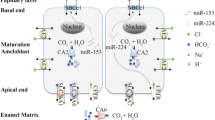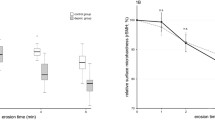Summary
The present study reports on the separation of fluid from soft, “cheeselike” enamel of porcine permanent teeth in the secretory stage, and the determination of its chemical composition. The enamel tissues were dissected from mandibles of 5 to 6-month-old piglets and pooled under mineral oil in centrifuge tubes, and then centrifuged at 1.9–2.4×105 g for 1–1.5 hours. The yields of the fluid were 44.8±2.3 (mean ± standard error) μl/g of enamel tissue at 1.9×105g, and 53.9±1.9 μl/g at 2.4×105 g. A significant finding was that the total Ca concentration of the enamel fluid (3.9–6.0×10−4 M) was lower than that of porcine serum (2.9×10−3 M), reflecting a distinct, compartmentalized microenvironment, isolated from the circulating blood. Another significant finding was that the ionic calcium activity (5.3×10−5 M) in the enamel fluid was one order of magnitude lower than the total Ca concentration. The averaged results of other determinations were: pH, 7.26; total [P], 3.9 mM; [Mg2+], 0.8 mM; [Na+], 140 mM; [K+], 20 mM; [Cl−], 150 mM; [F−], 5×10−3 mM; and osmolality of the fluid, 312 mosmol/kg H2O (in the same range as that of the serum, 310 mosmol/kg H2O). The apparent electrical unbalance of the analytical data, 8.65 meq excess of positive charges, was ascribed to the presence of HCO3 − in the fluid; the computed ionic strength was 164 mM. The free CA2+, calculated from the Ca2+ activity obtained by a Ca electrode, was 0.153 mM, suggesting that substantial amounts of calcium were bound, presumably by proteins or other binding species. The degree of saturation (DS) of enamel apatite, and other related calcium phosphates, was calculated based on the analytical results. The DS of the fluid with respect to enamel apatite indicated that the separated fluid was essentially in equilibrium with the existing crystals. The results suggest that enamel mineralization in the secretory stage may be regulated by a limited calcium supply through the ameloblast layer and the low level of calcium activity resulting from binding by proteins derived from the original organic matrix.
Similar content being viewed by others
References
Lowenstam HA (1981) Minerals formed by organisms. Science 211:1126–1131
Wilbur KM (1984) Many minerals, several Phyla, and a few considerations. Am Zool 24:839–845
Howell DS, Pita JC, Marques JF, Madruga JE (1968) Partition of calcium, phosphate, and protein in the fluid phase aspirated at calcifying sites in epiphyseal cartilage. J Clin Inv 47:1121–1132
Talmage RV (1969) Calcium homeostasis-calcium transport-parathyroid action. The effects of parathyroid hormone on the movement of calcium between bone and fluid. Clin Orthop 67:210–224
Scarpace PJ, Neuman WF (1976) The blood:bone disequilibrium I. The active accumulation of K+ into the bone extracellular fluid. Calcif Tissue Res 20:137–149
Nagai N, Frank RM (1975) Transfert du Ca45 par Autoradiographic en microscopie Electronique an Cours de L'Amelogenese. Calcif Tissue Res 19:211–221
Boyde A, Reith EJ (1977) Qualitative electron probe analysis of secretory ameloblasts and odontoblasts in the rat incisor. Histochem 50:347–354
Bawden JW, Wennberg A (1977) In vitro study of cellular influence on45Ca uptake in developing enamel. J Dent Res 56:313–319
Bawden JW, Merriff DH, Deaton TG (1981) In vitro study of calcium-45 and phosphorus-32 uptake in developing rat molar enamel using quantitative methods. Arch Oral Biol 26:477–482
Crenshaw MA, Takano Y (1982) Mechanisms by which the enamel organ controls calcium entry into developing enamel. J Dent Res 61 (Sp Iss):1574–1579
Eisenmann DR, Ashrafi SH, Zaki AE (1984) Calcium distribution in freeze-dried enamel organ tissue during normal and altered enamel mineralization. Calcif Tissue Int 36:596–603
Lyman GE, Waddell WJ (1977) pH gradients in the developing teeth of young mice from autoradiography of [14C]DMO. Am J Physiol 232:F364-F367
Robinson C, Briggs HD, Atkinson PJ, Weatherell JA (1984) Matrix and mineral changes in developing enamel. J Dent Res 58(B):871–880
Vogel GL, Chow LC, Brown WE (1983) A microanalytical procedure for the determination of calcium, phosphate and fluoride in enamel biopsy samples. Caries Res 17:23–31
Rankine CAN, Moreno EC, Vogel GL, Margolis HC (1985) Micro-analytical determination of pH, calcium and phosphate in plaque fluid. J Dent Res 64:1275–1280
Vogel AJ (1961) Quantitative inorganic analysis, 3rd ed. John Wiley & Sons, New York, p. 810
Vogel GL, Brown WE (1980) Microanalytical techniques with inverted solid state ion-selective electrodes. II. Microliter volumes. Anal Chem 52:377–379
Speirs RL (1975) Fluoride incorporation into developing enamel of permanent teeth in the domestic pig. Arch Oral Biol 20:877–883
Ahlberg M, Bawden JW, Hammarstrom LE, Hellborg R (1975) Proton activation analysis studies on fluorine and nitrogen content of developing dental enamel. Ondont Revy 26:267–280
Weatherell JA, Deutsch D, Robinson C, Hallworth AS (1977) Assimilation of fluoride by enamel throughout the life of the teeth. Caries Res 11 (Suppl 1):85–115
Neuman WF (1969) The milieu interieur of bone: Claude Bernard revisited. Fed Proc 28:1846–1850
Bawden JW, Wennberg A (1979) Ameloblasts-ion transport function. J Dent Res 58(B):708–713
Hammarstrom L (1971) Distribution in developing rat enamel of simultaneously injected fluoride and calcium. Scand J Dent Res 79:369–376
Lyaruu DM, Bronckers ALJJ, Burger EH, Woltgens JHM (1985) Localization of calcium in differentiating odonto-blasts and ameloblasts before and during early dentinogenesis and amelogenesis in hamster tooth germs. J Histochem Cytochem 33:595–603
Moreno EC, Zahradnik RT (1974) Chemistry of enamel subsurface demineralization in vitro. J Dent Res 53:226–235
Patel PR, Brown WE (1975) Thermodynamic solubility product of human tooth enamel: powdered sample. J Dent Res 54:728–736
Kaneko JJ (1980) Clinical biochemistry of domestic animals, 3rd ed. Academic Press, Orlando, Florida
Altman PL, Dittener DS (ed) (1974) Biology data book, 2nd ed, Vol. III, Fed Am Soc Exp Biol, Bethesda, pp 1839–1840
Dibdin GH, Shellis RP, Dawes C (1986) A comparison of the potassium content and osmolality of plaque fluid and saliva, and the effects plaque storage. J Dent Res 65:1053–1056
Harned HS, Owen BB (1958) The physical chemistry of electrolytic solutions, 32nd ed. Reinhold Publishing Co., New York, pp 615–618
Gregory TM, Moreno EC, Brown WE (1970) Solubility of CaHPO42H2O in the system Ca(OH)2−H3PO4−H2O at 5, 15, 25, and 37.5°C. J Res Nat Bur Stand 74A:461–475
Patel PR, Moreno EC, Patel JM (1971) Ionization of hydrofluoric acid at 25°C. J Res Nat Bur Stand 75A:205–211
Stability constants of metal-ion complexes, special pub No. 17 (1964). The Chemical Soc (London), Burlington House, (a) p 137, (b) p 182, (c) p 136
Kielland J (1937) Individual activity coefficients of ions in aqueous solutions. J Am Chem Soc 59:1675–1677
Moreno EC, Kresak M, Zahradnik RT (1977) Physicochemical aspects of fluorideapatite systems relevant to the study of dental caries. Caries Res 11 (Suppl 1):142–171
Moreno EC, Brown WE, Osborn G (1960) Stability of dicalcium phosphate dihydrate in aqueous solutions and solubility product of octacalcium phosphate. Soil Sci Soc Am Proc 24:99–102
Author information
Authors and Affiliations
Rights and permissions
About this article
Cite this article
Aoba, T., Moreno, E.C. The enamel fluid in the early secretory stage of porcine amelogenesis: Chemical composition and saturation with respect to enamel mineral. Calcif Tissue Int 41, 86–94 (1987). https://doi.org/10.1007/BF02555250
Received:
Revised:
Issue Date:
DOI: https://doi.org/10.1007/BF02555250




